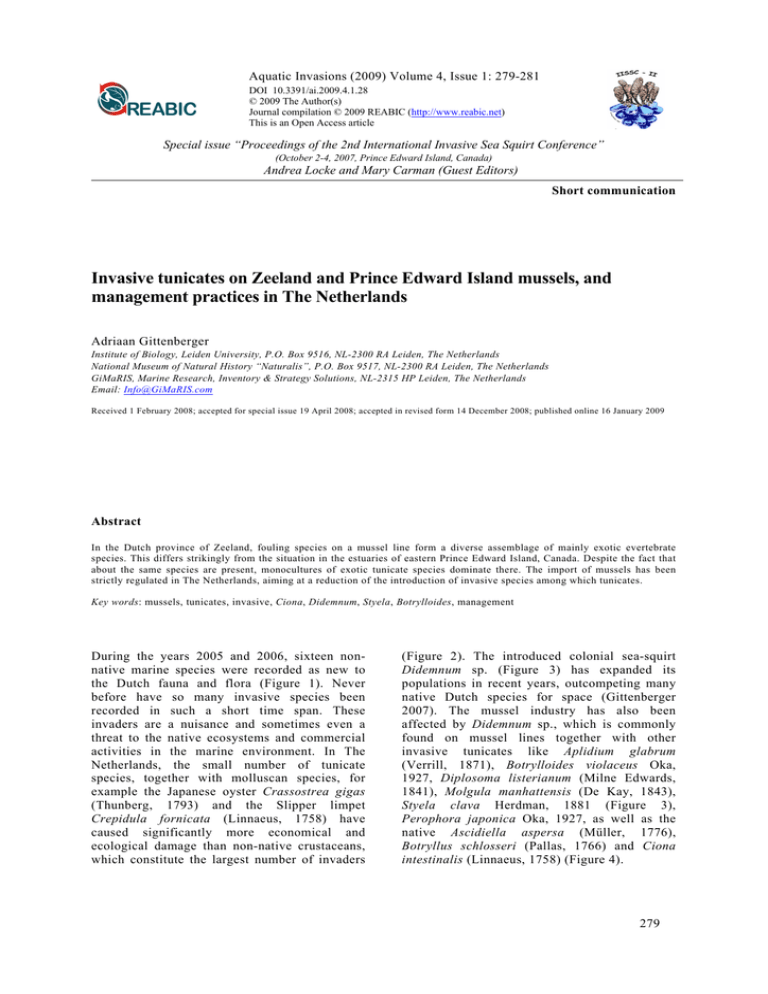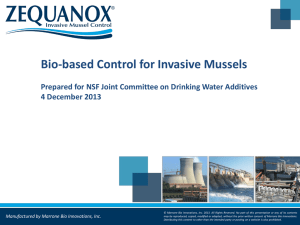Aquatic Invasions (2009) Volume 4, Issue 1: 279-281
advertisement

Aquatic Invasions (2009) Volume 4, Issue 1: 279-281 DOI 10.3391/ai.2009.4.1.28 © 2009 The Author(s) Journal compilation © 2009 REABIC (http://www.reabic.net) This is an Open Access article Special issue “Proceedings of the 2nd International Invasive Sea Squirt Conference” (October 2-4, 2007, Prince Edward Island, Canada) Andrea Locke and Mary Carman (Guest Editors) Short communication Invasive tunicates on Zeeland and Prince Edward Island mussels, and management practices in The Netherlands Adriaan Gittenberger Institute of Biology, Leiden University, P.O. Box 9516, NL-2300 RA Leiden, The Netherlands National Museum of Natural History “Naturalis”, P.O. Box 9517, NL-2300 RA Leiden, The Netherlands GiMaRIS, Marine Research, Inventory & Strategy Solutions, NL-2315 HP Leiden, The Netherlands Email: Info@GiMaRIS.com Received 1 February 2008; accepted for special issue 19 April 2008; accepted in revised form 14 December 2008; published online 16 January 2009 Abstract In the Dutch province of Zeeland, fouling species on a mussel line form a diverse assemblage of mainly exotic evertebrate species. This differs strikingly from the situation in the estuaries of eastern Prince Edward Island, Canada. Despite the fact that about the same species are present, monocultures of exotic tunicate species dominate there. The import of mussels has been strictly regulated in The Netherlands, aiming at a reduction of the introduction of invasive species among which tunicates. Key words: mussels, tunicates, invasive, Ciona, Didemnum, Styela, Botrylloides, management During the years 2005 and 2006, sixteen nonnative marine species were recorded as new to the Dutch fauna and flora (Figure 1). Never before have so many invasive species been recorded in such a short time span. These invaders are a nuisance and sometimes even a threat to the native ecosystems and commercial activities in the marine environment. In The Netherlands, the small number of tunicate species, together with molluscan species, for example the Japanese oyster Crassostrea gigas (Thunberg, 1793) and the Slipper limpet Crepidula fornicata (Linnaeus, 1758) have caused significantly more economical and ecological damage than non-native crustaceans, which constitute the largest number of invaders (Figure 2). The introduced colonial sea-squirt Didemnum sp. (Figure 3) has expanded its populations in recent years, outcompeting many native Dutch species for space (Gittenberger 2007). The mussel industry has also been affected by Didemnum sp., which is commonly found on mussel lines together with other invasive tunicates like Aplidium glabrum (Verrill, 1871), Botrylloides violaceus Oka, 1927, Diplosoma listerianum (Milne Edwards, 1841), Molgula manhattensis (De Kay, 1843), Styela clava Herdman, 1881 (Figure 3), Perophora japonica Oka, 1927, as well as the native Ascidiella aspersa (Müller, 1776), Botryllus schlosseri (Pallas, 1766) and Ciona intestinalis (Linnaeus, 1758) (Figure 4). 279 A. Gittenberger Figure 1. Number of non-native species recorded in the literature as new to the Dutch flora and fauna since 1951 Figure 2. Relative number of non-native marine and brackish water faunal groups recorded in The Netherlands. Modified after Gmelig-Meyling and Gittenberger (2006: 243, Figure 1d) Typically, the fouling species communities on mussel lines in The Netherlands consist of a mixture of tunicate, bryozoan, sponge, and seaanemone species, without clear dominance of a single species. This differs strikingly from what is found in the estuaries of eastern Prince Edward Island, Canada (e.g., Locke et al. 2007). There, fouling communities on mussel lines are usually dominated by a single tunicate species. High numbers of solitary tunicates such as the Vase tunicate Ciona intestinalis (Figures 4, 6) and the Clubbed tunicate Styela clava (Figure 8) can make the mussels very heavy (compare Figures 8 and 9), causing part of the yield to fall off when the lines are pulled out of the water. The colonial tunicates, i.e., the Violet tunicate Botrylloides violaceus (Figure 7) and/or the Golden star tunicate Botryllus schlosseri, do not substantially increase the mussel weight, and cause only minimal loss during harvesting (local mussel fisherman, personal communication. In The Netherlands, the import of mussel spat from Ireland and the transport of mussels within the country, from Zeeland to the Waddenzee, were temporarily halted in 2007, pending research results on the potential of the spat and Figures 3-5. Overgrown mussels in The Netherlands. 3, mussel line overgrown by the colonial tunicate Didemnum sp. (yellow colonies) and the solitary Styela clava (bottom left). 4, specimens of the native Ciona intestinalis on a mussel line. 5, mussels in a sealed package imported from the “North-East Atlantic” with a live specimen of Crepidula fornicata 280 Invasive tunicates on mussels and management practices Figures 6-9. Mussel lines, eastern part of Prince Edward Island, Canada. 6-8, mussels overgrown by non-native tunicates. 6, Ciona intestinalis. 7, Botrylloides violaceus. 8, Styela clava. 9, mussel line without overgrowth by invasive species mussels to harbor risky invasive species*. The reasons for this ruling were the increasing number of invaders in recent years, the high diversity of non-native species found on mussels, and the likely significant role of shellfishtransport as a distribution vector (Wolff 2005). The restrictions applied only to mussels that were imported for growing to maturity in open Dutch waters and not to mussels imported from the British Islands, Greece and Canada that were to be sold directly to consumers. These mussels are required to be cleaned before packing and transport but this is not always done carefully, and living Crepidula fornicata (Figure 5), barnacles and possibly tunicates might therefore still be imported into the Netherlands. However, these individuals will most probably not be able to reach a suitable habitat unless they are carelessly discarded alive. References Gittenberger A (2007) Recent population expansions of nonnative ascidians in The Netherlands. Journal of Experimental Marine Biology and Ecology 342: 122126 Gmelig Meyling AW, Gittenberger A (2006) Exoten en andere nieuwkomers in onze zoute wateren. De Levende Natuur 107: 242-246 Locke A, Hanson JM, Ellis KM, Thompson J, Rochette R (2007) Invasion of the southern Gulf of St. Lawrence by the clubbed tunicate (Styela clava Herdman): potential mechanisms for invasions of Prince Edward Island estuaries. Journal of Experimental Marine Biology and Ecology 342: 69-77 Wolff WJ (2005) Non-indigenous marine and estuarine species in The Netherlands. Zoologische Mededelingen 79: 1-116 * While this paper was in press, Dec. 4th 2008, the EU Court of Justice ruled against the Kingdom of the Netherlands and its restrictions system of prohibiting the import of mussels, without prior authorization, from other Member States. This would impede intra-Community trade for mussels from other EU Member States (Case C-249/07). 281





